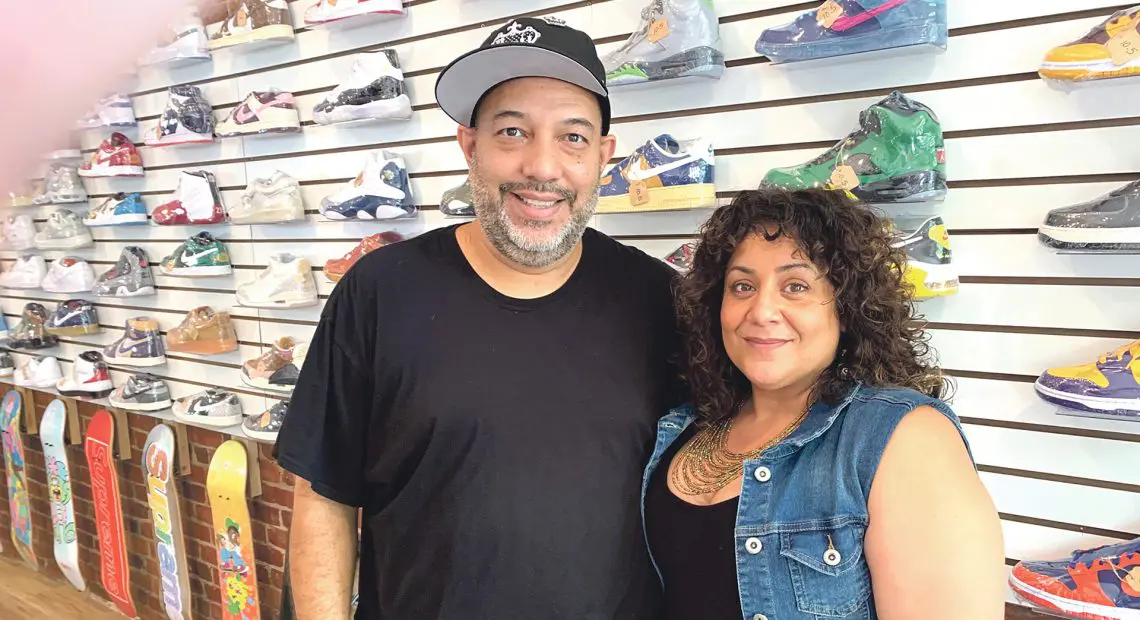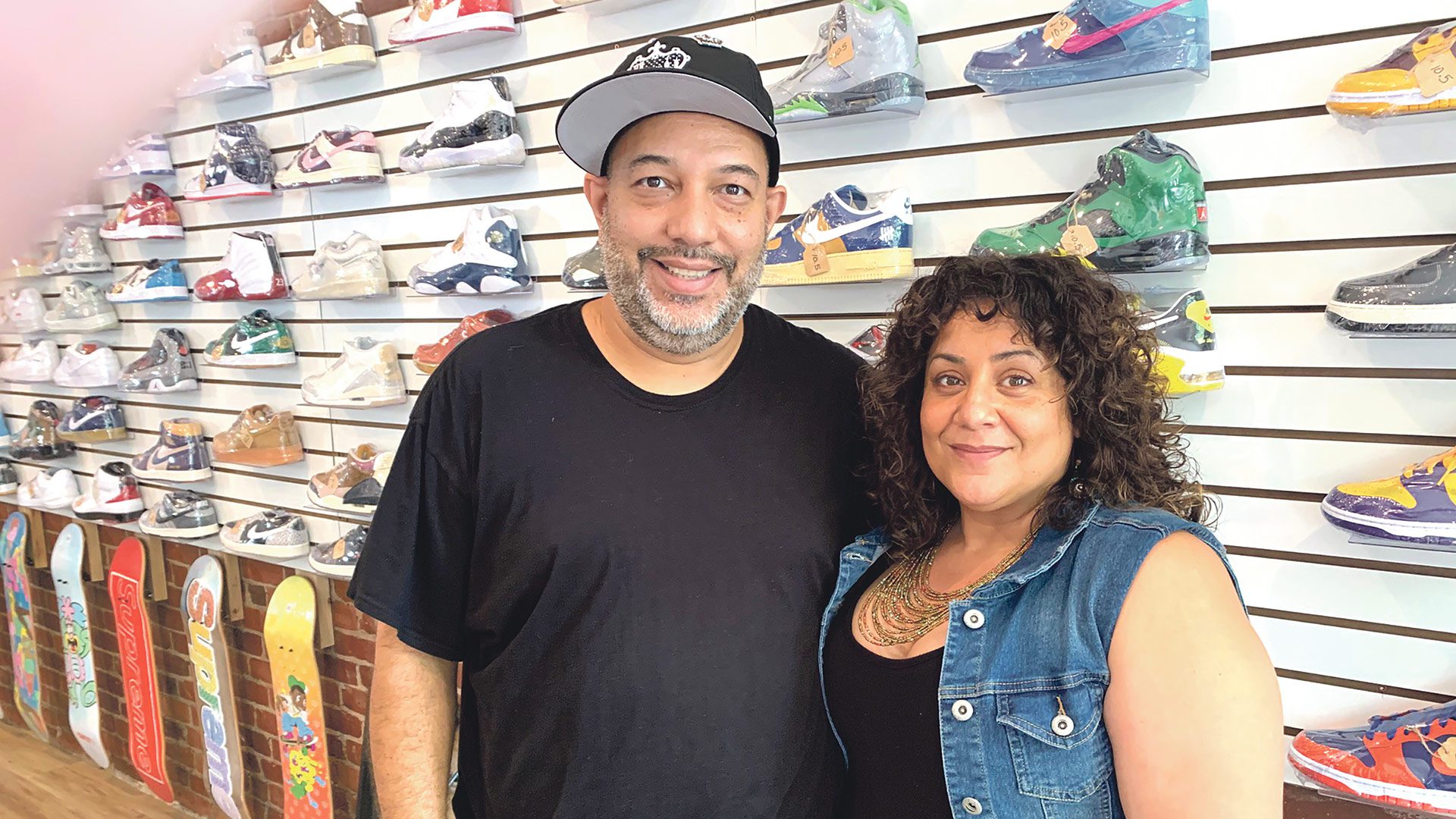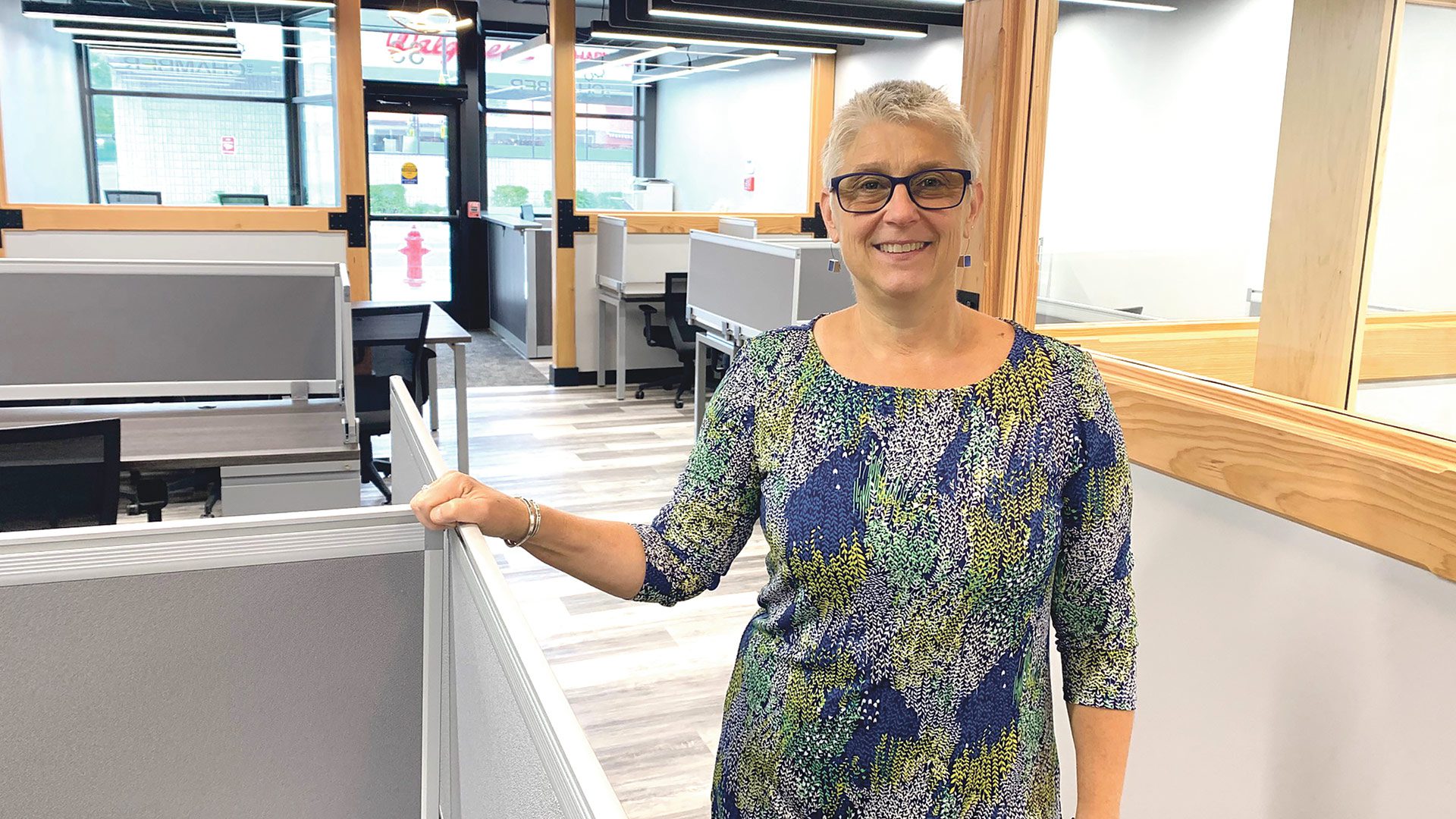
Easthampton and Its Lifestyle Are In Demand
Community Spotlight

Stacey Blanco and her husband, who opened Hide’n’ Sneakz, are among a growing number of small-business owners in Easthampton.
Stacey Blanco says she’s always been entrepreneurial.
Although she’s worked in office settings — and those experiences have helped inspire her current venture — she has preferred working for herself and has had side hustles, if you will, like teaching Zumba classes.
During the pandemic, she and her husband, Israel, began thinking about new business opportunities and needs they could meet. And they settled on footwear and related items and ultimately opened Hide’n’Sneakz in a storefront on Cottage Street. There, as the name suggests, they sell sneakers, but also apparel (such as T-shirts) and skateboards.
The store opened roughly 15 months ago, and not long thereafter, Stacey, seeking to learn more about the ins and outs of running a business — and improve her odds of success — became part of the first cohort for a new program created by the Greater Easthampton Chamber of Commerce called CO.STARTERS.
The 10-week entrepreneurial training program, lauched with $50,000 in ARPA funding, is designed for those who have started a venture, said Moe Belliveau, executive director of the chamber, but especially for those who are exploring a new idea or getting close to starting up. And it was conceived to complement, not compete with, other programs within the entreprenerial ecosystem, such as EforAll.
“It’s like a menu — we have a lot of different flavors. And that’s what we want to see in Easthampton; it’s what has made us so attractive to the people who want to come live here; it’s not one size fits all.”
“We cover everything from assumptions going in to your work style, knowing your customers to brand identity,” said Belliveau, adding that the first cohort drew some established business owners as well as those thinking about starting ventures ranging from a vegan restaurant to an outlet providing chef’s chothes for women.
“I wanted someone to check and see what I’ve been doing thus far and help me make wiser decisions about what directions to take next,” Blanco said, “and that’s what I found at CO.STARTERS.”
The iniative, soon to launch its second chort, is just one of the intriguing new programs at the chamber — another is its WorkHub on Union, a co-working space several years in the making that is set to open its doors next month — and one of many interesting storylines in this former mill city that has, over the past 30 years or so, reinvented itself as a home for the arts, hospitality businesses, and, well, entrepreneurs of all kinds.
It has become an increasingly popular place to live, work, and operate a business, said Dave DelVecchio, vice president of Marketing for Sourcepass, a national managed-IT services provider, who has lived in the city for 20 years now.
He praised a succession of municipal leaders with continually building on the progress made in various realms to create a very livable city that is continously raising the bar higher — and then clearing that bar.
“Easthampton has continually invested in ways that have been built upon itself,” he explained. “First it was a bike path by Millside Park, then it was ‘let’s clean up the back side of the mills on Pleasant Street to make them more accessible along the bike path and Millside Park.’ Then, it was ‘let’s do the pond project,’ then Union Street. Everything we’re doing is smaller-scale projects, but when you take the aggregate of everything that’s happened over 20 years, one plus one has equaled three, and it’s brought an uplift to Easthampton in general.”
Mayor Nicole LaChapelle agreed, noting that, in addition to new initiatives to support entrepreneurs and would-be entrepreneurs, the city is making strides in several other areas as well, including infrastructure and an issue impacting seemingly every community in the region — housing.
Indeed, there are several intriguing projects in the pipeline — and in a variety of different settings, from former mill buildings to decommissioned schools to wide-open space, as we’ll see — although most are at least a few years away.
“It’s like … hang on tight, housing units are coming, but they’re getting closer every day,” the mayor said, adding that there are a few hundred units of various types in the mix, additions that will certainly provide some intriguing options for the growing numbers of people who want to call Easthampton home.

Moe Belliveau stands in the soon-to-open WorkHub on Union at the chamber offices in Easthampton.
“It’s like a menu — we have a lot of different flavors,” LaChapelle said. “And that’s what we want to see in Easthampton; it’s what has made us so attractive to the people who want to come live here; it’s not one size fits all. You can live in a mill district and get that flavor or live in the middle of a pasture.”
For this, the latest installment of its Community Spotlight series, BusinessWest takes a hard look at Easthampton and the many forms of progress taking place in this community at the foot of Mount Tom.
Getting Down to Business
As Belliveau talked with BusinessWest at WorkHub on Union earlier this month, all was quiet.
Indeed, the rows of desks and half-desks (there are 18 in all), the conference room available for rent to tenants, and the common kitchen area were empty.
She expects things will be much different in a few weeks, when the facility officially opens its doors. She’s spent several years bringing her vision for the hub to fruition because she believes there’s a strong need for such a facility in Easthampton, and she expects its vast potential to be realized.
“We’ve had a lot of inquiries,” she said, adding that the $450,000 facilty was inspired by anecdotal but also statistical information indicating that there are large numbers of entrepreneurs working from their homes who would prefer to be in a co-working space if one became available to them. Also, there are professionals working remotely, fully or partially, who would likewise prefer not to be home on occasion.
“There’s a whole shadow economy in Greater Easthampton,” Belliveau explained. “And we’re trying to help those who are part of that informal, shadow economy into a more formal space and give them the opportunity to have professional space when they need it. And some people are finding that, since they’re working remotely, every now and then it’s just nice to be with others and get that creative-energy collaborative and their innovative juices flowing.”
WorkHub provides such opportunities, she said, adding that talk about creating such a facility began well before the pandemic, and the need has only increased since then.
DelVecchio, who has long been involved with the chamber, agreed, noting that iniatives like WorkHub on Union and CO.STARTERS represent a shift of sorts when it comes to the overall mission of the chamber.
“Traditionally, when people think about a chamber, the first thing that comes to mind is business-to-business networking — After-5 events — and that is a component to the overall chamber value proposition,” he explained. “But the chamber has other value propositions, one of which is economic development, particularly for budding entrepreneurs. So we see as part of our mission helping build the next generation of Greater Easthampton-based businesses and giving them an opportunity to build their organizations.”
Businesses like Hide’n’Sneakz, and entrepreneurs like Stacey Blanco.
She said she and Israel were attracted to Easthampton because of both the high energy there and the many forms of support for small businesses, especially at the chamber.
They took their concept to Cottage Street, and thus far they’re off to a solid start, said Stacey, adding that they spent much of their first year building visibility, setting goals, and developing a game plan for continued growth.
CO.STARTERS has played a big role in all that, she told BusinessWest, adding that she found, through the program, a solid support network providing both feedback and mentorship.
Easthampton at a glance
Year Incorporated: 1785
Population: 16,211
Area: 13.6 square miles
County: Hampshire
Residential Tax Rate: $13.56
Commercial Tax Rate: $13.56
Median Household Income: $45,185
Median Family Income: $54,312
Type of Government: Mayor, City Council
Largest Employers: Berry Plastics Corp., INSA, Williston Northampton School, National Nonwovens Co.
* Latest information available
Overall, their venture looks to meet what they consider a need — there isn’t a store like this in Easthampton, and its prices are lower than what can be found at the mall — while also promoting sneakers as, among other things, wellness.
“I think a great pair of sneakers will change your attitude for the day,” she explained. “I’ve worked in the office, in the corporate world, and you always had to wear uncomfortable shoes; I’m trying to promote how you can wear a nice pair of sneakers with casual work pants, and you’re going to have a really comfortable day at work.”
Building Momentum
It’s called the Growing Green project.
This is one of several housing initiatives unfolding in the community, each one different, and each one with a story behind it.
Growing Green is a rural project planned for 56 acres just off Main Street near the border with Southampton. It’s a partnership between the Kestrel Land Trust and the Community Builders Inc. said LaChapelle, adding that 22 of those acres will be set aside for housing — 87 units in the affordable category — and the rest will be preserved as open space, with Kestrel and the Massachusetts Audubon Society overseeing the conservation.
“It’s a very interesting project — it’s really cutting-edge,” said the mayor, adding that the initiative will soon be the focus of an upcoming article in Sierra, the magazine of the Sierra Club, because of the way it demonstrates that new housing (a regional and national issue) and land preservation can be undertaken in the same project.
The new units of housing are expected to come online in 2028 or 2029, with the ultimate timing to be influenced by when the developers can secure low-income-housing tax credits, said LaChapelle, adding that other housing initiatives in the community are decidedly more urban in nature.
They include redevelopment of one of the two remaining former mill buildings in the Ferry Street complex — Building 11 to be specific (leaving the largest of the mills, Building 7 still to be developed), said the mayor, adding that this project, being undertaken by Springfield-based Home City Development Corp., will create 96 units of housing — 90 in the ‘affordable’ category, with the other six being market rate. Low-income tax credits will be needed for this project as well, she said, adding that the hope is that these units can come on line at the end of 2026.
Meanwhile, more housing is planned for three recently decommissioned schools — Maple, Center, and Pepin — into 69 units for those of mixed incomes, said the mayor, ading that the buildings “triangulate” the downtown district.
Also, what’s known as the original Town Lodging House on Oliver Street, known to many as the ‘Poor House,’ is being renovated into housing (perhaps 30 units in the affordable category) by the city in partnership with Valley CDC in an initiative with another long time horizon — 2029 at the earliest.
“That’s a building with a lot of restrictions — there’s a historical restriction on it, an affordable-housing restriction on it, there’s an agricultural restriction on it … it’s very complex to develop,” LaChapelle said. “But historically, it’s a very cool project, and Valley CDC has been working with the city to keep those aspects — some of the history of the building, some of the architecture — while putting together modern housing units.”
These projects comprise several hundred units that are needed, not just because of overall demand for housing, she said, but due to a need, in these changing times, of housing of a somewhat non-traditional sense.
“There’s just a conundrum around housing these days,” she told BusinessWest. “When you close you eyes and dream the American dream in New England, it’s literally a white house with black shutters and a picket fence. There simply isn’t enough land for that, and it doesn’t fit the lifestyle like it did 25 or 30 years ago. With the housing units we have planned, there’s a big cross-selection; with those three schools in the downtown, there’s high walkability — you can park your car and forget about it for a week.”
Like the mayor said, there’s a full menu of options — and a wide range of growth opportunities — in a community that has come a long way in 30 years and continues the process of reinventing itself into a dynamic, in-demand community.





